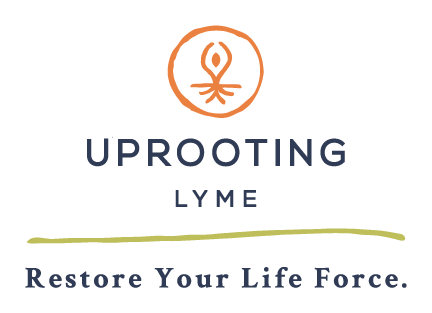
FIRST AID FOR TICK BITES & LYME DISEASE PREVENTION
Lyme Disease is a serious health threat to people of every age, race, and creed who live in the Hudson Valley, and many other areas across the country too. The truth is, knowledge is power, and we need to learn how to respond to the threat of Tick Bites and Lyme disease with intelligence and discernment.
Avoid Getting Bit By Ticks
Following are recommended ways to avoid getting bit by ticks in the first place, short of staying indoors, which doesn’t seem to me like a very healthy solution. You might choose those options that work best for you.
- Wear lightweight, long-sleeve shirts and long pants tucked into socks when gardening or hiking in known tick-infested places.
- Wear light colored clothing so you are more likely to see a tick crawling on your clothes.
- Pay attention to minor itches and crawling sensations on your skin – check it out to make sure it’s not a tick.
- Wear natural insect repellant, such as Welcome To The Woods Insect Repellant in lotion or spray form. Apply it frequently, as in every couple of hours, if you are outside for an extended period of time.
Deet-based repellant is too toxic to be a valid option, especially for children, as are all chemical insecticides. The more we pollute our bodies and the planet, the more we will continue to make ourselves vulnerable to infinite iterations of chronic multi-pathogen, multi-system diseases, which is the nature of chronic Lyme disease. If you do get infected by Lyme, you are going to want your body to be as clean and alkaline on the inside as possible, not a toxic, acidic breeding ground for bacteria such as Borrelia, the spirochete that causes Lyme disease.
- Once inside, remove all clothing and put them into the wash, and more importantly, dry them on high heat to kill any ticks that may be attached to them. Then take a shower if possible.
- Check your body for ticks twice per day, especially the groin area, within the hairline of the head, and all around the torso where the body heat is higher.
- Teach your children (by the age of 3 or 4 at the latest) how to identify a tick so that if they see one on their body or yours, they know to seek an adults’ assistance to remove it safely and swiftly.
Tick Removal
Many people follow all of the best practices to avoid getting bit by a tick, and still discover ticks on them in the act of latching on, or at some point in the feeding process. Yuck! So, what to do when you find a tick on your body?
- Keep handy – in your medicine cabinet, car, camping gear, purse, etc. – a good pair of tick removal tweezers. My favorite come in a kit from Mainely Ticks because they have a small magnifying glass attached to them, so you can see what you’re doing when trying to remove even the tiny nymph ticks, and the heads, which brings me to my next point.
- The key to successful, safe tick removal is removing the tick by its head, which is where it has embedded itself into your skin. The trick is to grab hold of the head of the tick, not the body, as you might pull off the body and leave the head behind, which may be strongly attached into the skin. Slide one side of the tweezers under the head of the tick, and peel the head and body of the tick up and away.
- If the tick body is engorged and you were able to remove it in one piece, you may want to send it to a lab to find out if the tick was carrying the Borrelia burgdorferi bacteria that causes Lyme disease, in which case you’ll want to preserve the tick in a plastic Ziploc (keep these handy with your tweezers).
Treatment of the bite to prevent Lyme disease
- After removing the tick, unless it was barely attached to the skin at all, you’ll want to put clove essential oil directly onto the skin beyond the circle of redness at the bite.
If the Borellia spirochete enters your body, it remains initially superficial in the tissue layers of the skin at first. The clove oil is absorbed into the layers of the skin and is a powerful antibiotic and anti-spirochete agent. This is much more effective than washing the bite with soap or alcohol, as is often recommended.
Based on my personal and clinical experience, the prompt use of clove oil is the #1 way to reduce incidence of Lyme disease from a tick bite, even one that looks very angry and infected. Within 12-24 hours, the redness, swelling, itching, and rash is greatly diminished. My family and patients have used this technique 100’s of times, and I’ve never known a tick bite that was treated with clove oil to lead to Lyme disease. Be sure to continue applying the clove oil twice per day until all signs of infection and irritation from the bite have cleared.
Other Natural Prophylactic Measures
- Take an immune system booster such as Echinacea tincture, which activates your acute immune response against pathogenic invaders such as bacteria and viruses (including Borrelia spirochetes).
- Take an Anti-Lyme Herbal Formula. If you do get bit by a tick and it was on you long enough to carry a threat of Lyme disease, then getting herbs into your bloodstream that kill the spirochete and make your body inhospitable ahead of time, is a smart way to head off the potential for infection to develop.
- Take extra measures to alkalize your blood (like drinking water with lemon, and green vegetable juices), strengthen your immune system (by getting enough rest, for example) and minimize intake of bacteria-feeding sugar, white flours, and alcohol.
If you are confused about whether or not you have Lyme, a co-infection, or other complex chronic disease, call us at 845-687-6211 or email info@uprootinglyme.com to set up an in-person or virtual holistic Lyme consultation at reasonable rates. We’ll help you interpret your labs and co-create a strategic holistic treatment plan. Navigating Lyme disease is confusing, and confusion can cost you time and money that could be spent on getting the treatment you need. Contact us now!






Evoryene would benefit from reading this post
Great article! Really helpful tips for dealing with tick bites and preventing Lyme disease.